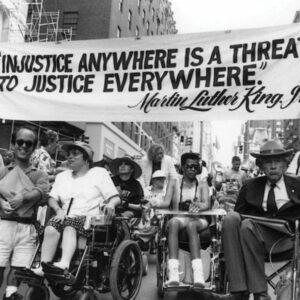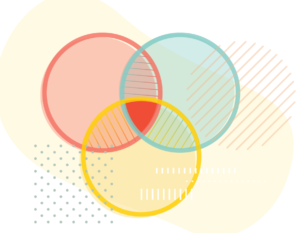Date: Feb. 25 @ 7:00 pm
Zoom Link: Bit.ly//AAUWBennVCIL
Lynn Mazza will give a talk and facilitate discussion of the intersectionality of the Civil Rights Movement from the perspective of the Disability Movement. Led by people of color, the Civil Rights Movement inspired and overlapped with the history of the disability movement and that of other minority, marginalized or oppressed identity groups. The program will look at how solidarity is evolving both in terms of microaggressions and interpersonal etiquette and in terms of identity politics.

Photo of 1970s ADAPT demonstration where there is a row of people using wheelchairs on a city the street holding up a banner with the MKL quote “Injustice anywhere is a threat to justice everywhere.”
Resources: Racial microaggressions are making Black people sick – The Washington Post
ABOUT THE SPEAKER

LYNN MAZZA
Lynn Mazza is social justice activist who identifies as a person with a disability. She works as peer advocate counselor at Vermont Center for Independent Living in Bennington (VCIL), one of 6 state-wide branches. In 1979, representatives from several regional cross-disability groups organized to create what is now VCIL. The purpose of the VCIL is to provide people with disabilities with better information, one-to-one peer support in dealing with disability issues, and the opportunity for small groups to meet to work together to make Vermont communities friendlier and more accessible to all people with disabilities.
What is Intersectionality? 
From the AAUW website:
People yearn to be their true selves at work, at school, in their lives in general — we all want to be able to embrace our full identity. But to do that, we have to understand the concept of intersectionality because who you are is a combination of many different identities. The effects of which are not always the same in every circumstance.
Legal scholar Kimberlé Crenshaw originally coined the term intersectionality in her work Mapping the Margins. She pointed out that scholars often look at outcomes for women or outcomes for African Americans, but never look at what happens to African American women whose lives are impacted by the ways these multiple sources of oppression interact. And with that a new way of examining the experiences of people with overlapping dimensions of diversity was born.
Understanding intersectionality gives us a way of understanding the cumulative effect of discrimination and oppression on people. That’s not to say that one person’s oppression is greater than another’s; it’s simply a way of recognizing that our experiences may not be the same because inequality is a complex phenomenon.
Additional Reading:
Disability Rights in the 1960’s and 70’s https://guides.ll.georgetown.edu/c.php?g=592919&p=4186694
Microaggressions:
Article in today’s Guardian.
I would say our reading of The Night Watchman was pretty darned timely!
Return to Table of Contents
